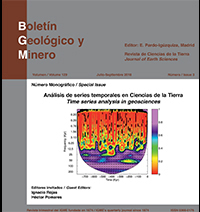Ascertaining evapotranspiration series by the optimized rainfall-runoff model
DOI:
https://doi.org/10.21701/bolgeomin.129.3.001Keywords:
calibration, evapotranspiration, long-term time series, optimization, SAC-SMA modelAbstract
Considerable long-term time series of precipitations and air temperature changes were used for modelling the rainfall-runoff process. The time series were also used for the accurate assessment of the evapotranspiration demand of the Czech Elbe River. Random fluctuations of vegetation cover are taken as an indication of deviations in the evapotranspiration. The intention is to appraise such complicated time series as a long-term process. The recently modified software of the conceptual SAC-SMA model firstly enables a prompt simulation and secondly creates the conditions for automatic calibration of this model. This tool provides a separate simulation for each partial time interval with diverse expected values of evapotranspiration. This may be ascertained during the consecutive identification of optimal model parameters. The resulting evapotranspiration values are represented as outputs of modelling; these output values would be difficult to obtain from meteo-observations, e.g. measured data or computed values.
Downloads
References
Beer, J. 2005. Solar variability and climate change. Memorie-Società Astronomica Italiana, 76 (4), 751.
Brown, T. 1997. Clearances and clearings: deforestation in Mesolithic/Neolithic Britain. Oxford Journal of Archaeology, 16 (2), 133-146. https://doi.org/10.1111/1468-0092.00030
Buchtele, J. and Koskova, R. 2008. Approaches to credible identification of reliable parameters in rainfall-runoff model from long time series. HydroPredict'2008, Prague, 241-244.
Buchtele, J. and Tesar, M. 2013. Influence of the vegetation cover development at the water regime from surface and groundwater storages. Water Managment, 8, 34-39.
Burnash, R. and Ferral, R. 1973. A generalized streamflow simulation system. Conceptual modeling for digital computers. National Weather Service, 134 pp.
Gilli, M. 2004. An Introduction to Optimization Heuristics. In: Department of Econometrics, University of Geneva and FAME, Seminar University of Cyprus.
Hurst, H.E. 1951. Long-term storage capacity of reservoirs. Transactions of the American Society of Civil Engineers, 116 (2), 770-799. https://doi.org/10.1061/TACEAT.0006518
Hyndman, R. J., and Koehler, A. B. 2006. Another look at measures of forecast accuracy. International Journal of Forecasting, 22 (4), 679-688. https://doi.org/10.1016/j.ijforecast.2006.03.001
Chlumecky, M. 2013. Optimizing of parameters in model (SAC-SMA). POSTER 2013 - 17th International Student Conference on Electrical Engineering. Prague, 1-6
Jewitt, G.P.W., Garratt, J.A., Calder, I.R. 2004. Water resources planning and modelling tools for the assessment of land use change in the Luvuvhu Catchment. Physics and Chemistry of the Earth, 29 (15), 1233-1241. https://doi.org/10.1016/j.pce.2004.09.020
Koren, V. I., Finnerty, B. D., Schaake, J. C., Smith, M. B., Seo, D. J. and Duan, Q. Y. 1999. Scale dependencies of hydrologic models to spatial variability of precipitation. Journal of Hydrology, 217 (3), 285-302. https://doi.org/10.1016/S0022-1694(98)00231-5
Kuczera, G. 1997. Efficient subspace probabilistic parameter optimization for catchment models. Water Resources Research, 33, 177-185. https://doi.org/10.1029/96WR02671
Kundzewicz, Z.W. 2007. Prediction in ungauged basins - a systemic perspective. Predictions in ungauged basins, Brasilia, 309, 38-47.
Kunkel, R. and Wendland, F. 2002. The GROWA98 model for water balance analysis in large river basins - the river Elbe case study. Journal of Hydrology, 259, 152-162 https://doi.org/10.1016/S0022-1694(01)00579-0
Leprieur, C., Kerr, Y.H., Mastorchio, S. 2000. Monitoring vegetation cover across semi-arid regions: comparison of remote observations from various scales. International Journal of Remote Sensing, 21(2), 281-300. https://doi.org/10.1080/014311600210830
Merz, R., Blöschl, G., Parajka J. 2006. Regionalization methods in rainfall-runoff modelling using large catchment samples. IAHS publication, 307, 117.
Vicente-Serrano, S. M., Beguería, S. and López-Moreno, J. I. 2010. A multiscalar drought index sensitive to global warming: the standardized precipitation evapotranspiration index. Journal of Climate, 23 (7), 1696-1718 https://doi.org/10.1175/2009JCLI2909.1
Vrugt, J. A., Gupta, H. V., Bastidas, L. A., Bouten, W. and Sorooshian, S. 2003. Effective and efficient algorithm for multiobjective optimization of hydrologic models. Water Resources Research, 39 (8), 1214 https://doi.org/10.1029/2002WR001746
Wagener, T., Wheater, H. S. and Gupta, H. V. 2004. Rainfallrunoff modelling in gauged and ungauged catchments. Imperial College Press, London, 306pp. https://doi.org/10.1142/9781860945397
Winker, P. and Gilli, M. 2004. Applications of optimization heuristics to estimation and modelling problems. Computational Statistics & Data Analysis, 47 (2), 211-223 https://doi.org/10.1016/j.csda.2003.11.026
Downloads
Published
How to Cite
Issue
Section
License
Copyright (c) 2024 Consejo Superior de Investigaciones Científicas (CSIC)

This work is licensed under a Creative Commons Attribution 4.0 International License.
© CSIC. Manuscripts published in both the print and online versions of this journal are the property of the Consejo Superior de Investigaciones Científicas, and quoting this source is a requirement for any partial or full reproduction.
All contents of this electronic edition, except where otherwise noted, are distributed under a Creative Commons Attribution 4.0 International (CC BY 4.0) licence. You may read the basic information and the legal text of the licence. The indication of the CC BY 4.0 licence must be expressly stated in this way when necessary.
Self-archiving in repositories, personal webpages or similar, of any version other than the final version of the work produced by the publisher, is not allowed.
Funding data
České Vysoké Učení Technické v Praze
Grant numbers SGS16/091/OHK3/1T/1















